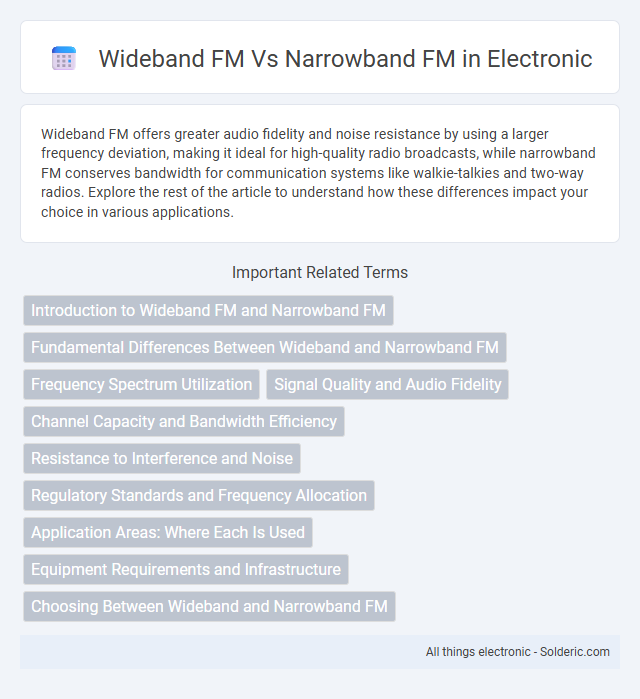Wideband FM offers greater audio fidelity and noise resistance by using a larger frequency deviation, making it ideal for high-quality radio broadcasts, while narrowband FM conserves bandwidth for communication systems like walkie-talkies and two-way radios. Explore the rest of the article to understand how these differences impact your choice in various applications.
Comparison Table
| Feature | Wideband FM (WBFM) | Narrowband FM (NBFM) |
|---|---|---|
| Bandwidth | Typically 200 kHz or more | Usually 12.5 kHz to 25 kHz |
| Frequency Deviation | +-75 kHz (e.g., FM broadcast) | +-2.5 kHz to +-5 kHz |
| Audio Quality | High-fidelity audio, wide dynamic range | Lower audio quality, voice communication focus |
| SNR (Signal-to-Noise Ratio) | Better SNR, less noise interference | Moderate SNR, more susceptible to noise |
| Applications | FM radio broadcasting, high-quality audio systems | Two-way radio, walkie-talkies, public safety communications |
| Power Efficiency | Lower power efficiency | Higher power efficiency |
| Complexity | More complex transmitter and receiver design | Simpler design, cost-effective |
Introduction to Wideband FM and Narrowband FM
Wideband FM (WBFM) offers a larger frequency deviation, typically greater than 75 kHz, enabling higher audio quality and improved noise immunity compared to Narrowband FM (NBFM), which operates with frequency deviation less than 5 kHz. WBFM is commonly used in high-fidelity broadcasting and music transmission, while NBFM suits voice communications where bandwidth efficiency is crucial. Your choice between Wideband and Narrowband FM should consider the trade-off between audio fidelity and spectral efficiency for specific applications.
Fundamental Differences Between Wideband and Narrowband FM
Wideband FM (WBFM) and Narrowband FM (NBFM) primarily differ in their frequency deviation and bandwidth usage, with WBFM offering a deviation greater than 5 kHz and a wide bandwidth suitable for high-fidelity audio transmissions. NBFM features smaller frequency deviation, typically under 5 kHz, allowing efficient spectrum use ideal for voice communications in commercial and two-way radio applications. Your choice between wideband and narrowband FM impacts signal quality, bandwidth requirements, and interference resistance depending on the communication system's needs.
Frequency Spectrum Utilization
Wideband FM (WBFM) uses a significantly larger frequency deviation, typically around 75 kHz, resulting in a broader frequency spectrum usually spanning up to 200 kHz, which enhances audio quality and noise resistance but demands more bandwidth. Narrowband FM (NBFM) generally limits frequency deviation to 2.5 kHz or less, conserving spectrum and making it suitable for voice communications where bandwidth efficiency and channel capacity are critical. Your choice between WBFM and NBFM depends on balancing the need for audio fidelity against spectral efficiency in various communication systems.
Signal Quality and Audio Fidelity
Wideband FM provides superior signal quality and audio fidelity due to its larger frequency deviation, allowing better noise rejection and clearer sound reproduction than narrowband FM. Narrowband FM, limited by its smaller deviation, often suffers from reduced audio clarity and increased susceptibility to interference, making it less ideal for high-quality audio transmissions. You will notice a significant improvement in listening experience with wideband FM, especially in applications requiring high-fidelity sound.
Channel Capacity and Bandwidth Efficiency
Wideband FM (WBFM) offers higher channel capacity due to its larger frequency deviation, allowing for improved sound quality and better noise resistance but at the cost of increased bandwidth usage typically around 200 kHz. Narrowband FM (NBFM) uses a smaller frequency deviation, resulting in greater bandwidth efficiency by conserving spectrum space with bandwidths usually less than 25 kHz, making it suitable for voice communication in crowded frequency bands. Your choice between WBFM and NBFM depends on the balance you need between high-fidelity transmission and efficient spectrum utilization.
Resistance to Interference and Noise
Wideband FM offers significantly better resistance to interference and noise due to its larger frequency deviation, which allows for improved signal-to-noise ratio and enhanced audio quality. Narrowband FM, with a smaller frequency deviation, is more susceptible to noise and provides less effective suppression of interference in crowded or noisy environments. Choosing wideband FM for your communication system ensures clearer reception and more reliable performance in challenging signal conditions.
Regulatory Standards and Frequency Allocation
Wideband FM (WBFM) typically operates in commercial broadcasting, adhering to regulatory standards that allocate bandwidths up to 200 kHz to support high-fidelity audio transmission. Narrowband FM (NBFM) is regulated under stricter frequency allocation rules, often limited to 12.5 kHz or less, to ensure efficient spectrum usage in communication services like two-way radios and public safety channels. Understanding these regulatory constraints helps you optimize your system's compliance and performance within assigned frequency bands.
Application Areas: Where Each Is Used
Wideband FM is commonly used in high-fidelity audio broadcasting, such as commercial FM radio stations and television audio transmission, due to its superior noise immunity and sound quality. Narrowband FM is preferred in communication systems requiring efficient bandwidth usage and long-range transmission, including two-way radios, public safety communication, and amateur radio. Both modulation types cater to specific application needs based on factors like bandwidth availability, signal clarity, and regulatory constraints.
Equipment Requirements and Infrastructure
Wideband FM requires more advanced and expensive equipment, including higher-capacity transmitters and wider bandwidth channels, compared to narrowband FM, which operates with simpler, cost-effective devices and narrower channels. The infrastructure for wideband FM demands robust frequency allocation and more stringent regulatory compliance due to its larger spectral footprint. Your choice between wideband and narrowband FM will significantly impact the complexity and cost of the communication system's deployment and maintenance.
Choosing Between Wideband and Narrowband FM
Choosing between wideband FM and narrowband FM depends on the specific application and regulatory requirements. Wideband FM offers superior audio quality and noise immunity due to its larger frequency deviation, making it ideal for high-fidelity broadcasts and professional communications. Narrowband FM is more spectrum-efficient with lower bandwidth usage, suitable for two-way radios and communication systems prioritizing channel capacity and range over audio fidelity.
wideband FM vs narrowband FM Infographic

 solderic.com
solderic.com